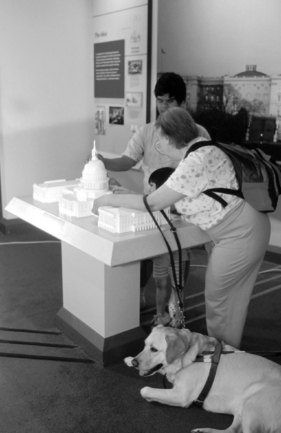5 Psychosocial and Therapeutic Aspects of Human-Animal Interaction
People derive physiological and psychological benefits from interactions with animals. Animals can play a therapeutic and health-promoting role in a wide variety of human health conditions and in settings ranging from the community to primary, inpatient, and long-term health care. Human and veterinary health care providers need to be aware of the potential health benefits of human-animal interaction (HAI) and the important role that the human-animal bond may play in the health status of patients. This chapter outlines some of the therapeutic uses of animals and other psychosocial issues related to the human-animal bond (Figure 5-1).

Figure 5-1 A child interacting with her dog.
(From Centers for Disease Control and Prevention: Healthy pets, healthy people: infants and young children. http://www.cdc.gov/healthypets/child.htm.)
Human Health Clinicians
Veterinary Clinicians
HUMAN-ANIMAL INTERACTION: ANIMAL-ASSISTED ACTIVITY, ANIMAL-ASSISTED THERAPY, AND SERVICE DOGS DEFINED
As Box 5-1 demonstrates, service dogs (Figure 5-2) are currently used in long-term patient-animal relationships for a variety of health care settings, both in institutional and home-based care.
BOX 5-1 USES OF AAA, AAT, AND SERVICE DOGS
From the Delta Society, Bellevue, Wa.
General Assistance, Including
HEALTH BENEFITS OF HUMAN-ANIMAL INTERACTION
Research into the health benefits of HAI began in the late 1970s with a study of nursing staff perceptions of psychosocial benefits of older adults interacting with a cat mascot in long-term care.2 Subsequently, despite a growing number and wide range of studies that have been conducted with varying populations, there remain methodological issues associated with small samples, nonexperimental designs, nonrandomized treatment groups, and the influence of confounding variables.3
One problem commonly seen in literature discussing benefits of HAI is the assumption that similar health effects are found in pet ownership (or with service animals) and more casual pet interaction contexts, such as AAA or AAT. It is important to identify the distinction and to clarify these terms because pet/service animal ownership implies a longer, more committed relationship than what can be relatively brief encounters in other pet interactions. In many cultures, companion animals are viewed as family members, occupying homes, sleeping on human beings’ beds, and sharing food and recreational activities—they are treated almost as children.4,5 The distinction is made between this long-term relationship and more casual encounters in which people interact with companion animals in public or in therapeutic contexts, such as schools, clinics, or a range of health care facilities (AAA and AAT).
Several physiological benefits of HAI have been found in AAA, AAT, and pet ownership contexts (Table 5-1). The strong bond that human beings can develop with animals may stem from an innate human affinity with nature, including animals (termed biophilia, the love of living things6), predicated on the dependence of human beings on animals for food throughout history.7 This natural tendency may help to provide an understanding of some of the effects of HAI.
Table 5-1 Research Evidence Showing Physiological Benefits of HAI
| Benefit | Population | Pet Ownership (O), AAA, or AAT |
|---|---|---|
| Decreased cortisol levels | Adults with own or unfamiliar pet | O |
| Decreased blood pressure and heart rate/cardiovascular reactivity | Adults | O, AAA |
| Increased parasympathetic nervous system activity | Adults | O, AAA |
| Increased phenylethylamine, prolactin, oxytocin, serotonin | Adults with own or unfamiliar pet | O, AAA |
| Decreased pain, analgesia use, anxiety, and epinephrine levels | Adults | AAA |
| Decreased cholesterol and triglyceride levels | Adults | O |
| Better 1-year survival after myocardial infarction | Adults | O |
| Buffered blood pressure response to stress in hypertensive patients treated with lisinopril | Adults | O |
| Fewer patient-initiated physician visits | Elderly | O |
| Improved self-perceived health | Elderly | O |
| Increased physical activity levels and weight loss with dog walking | Adults and elderly | O, AAA |
| Increased longevity | Elderly | O |
| Increased food intake (with aquarium watching) | Elderly | AAA |
| Decreased muscle spasticity | Children with cerebral palsy | AAA, AAT |
AAA and AAT: Psychological and Psychosocial Effects
Clinical evidence indicates that even in therapeutic settings, in relatively short encounters with varying degrees of frequency, an intense attachment can rapidly develop between people and pets. In a laboratory setting serum cortisol levels were found to decrease when people interacted quietly with a dog.9 During this interaction, additional beneficial changes in neurohormones were found (phenylethylamine, prolactin, oxytocin, dopamine, and endorphin levels increased significantly), as was a significant decrease in blood pressure. A parallel result was found in the dogs during the interaction, suggesting that they also benefited. Similarly, investigators found significantly smaller increases in blood pressure and heart rate when a dog was present during challenging mathematical tasks than when either a friend or an investigator was present.10
In a therapeutic horsemanship context, a relaxation response was observed in children with spastic cerebral palsy who experienced 8 minutes of riding. Electromyogram readings showed improved symmetry in muscle activity both during and for some time after the riding episodes.11 Improved walking and muscle coordination also has been found in disabled children after therapeutic horseback riding.12 Generally, children have been an understudied population in the HAI literature. Preliminary findings seem promising but additional data are needed to clarify the most beneficial contexts for AAT and AAT in children.
In clinical settings, hospitalized patients reported less pain and used fewer analgesics during and after an animal visit,13 and patients with heart failure had decreased anxiety and epinephrine levels during and after an animal visit.14 For older adults with dementia in long-term care settings, watching fish swim in an aquarium at mealtimes was associated with longer periods sitting to eat and greater nutritional intake (Figure 5-3).15 Newly admitted nursing home residents exposed to a series of dog visits were found to have lower cortisol levels than those who had human visitors.16

Figure 5-3 Watching fish swim in an aquarium has a relaxing effect on human beings.
(From Mitchell M, Tully TN Jr: Manual of exotic pet practice, St Louis, 2008, Saunders Elsevier. Photo courtesy Trevor Zachariah.)
Among community-dwelling older adults, walking with a “loaner” dog was associated with significantly greater parasympathetic nervous system activity (high-frequency heart rate variability) than walking without a dog.17 When participants interacted quietly with the dog while it visited them in their own home, this activity increased by 1.87 times over their levels while at home without the dog. In overweight residents of public housing, an adherence rate of 72% and average weight loss of 14 pounds in a “loaner” dog-walking program was demonstrated because the participants believed that “the dogs need us to walk them.” Participants in a community shelter dog-walking program were motivated to increase their exercise outside the walking program. Investigators found a significant increase in exercise and physical activity stage of change (participants went from vigorous exercise less than three times per week or moderate exercise less than five times per week to 30 minutes a day of moderate exercise five or more days per week for 1 to 5 months).18
A variety of psychosocial benefits have been reported by investigators studying outcomes of AAA and AAT (Table 5-2).19 These benefits include increased social contact, reduced loneliness and depression in hospitalized patients and homeless persons,20,21 and decreased anxiety in psychiatric patients.22 The most commonly studied context is long-term care. For example, one study found nursing home residents’ prosocial behavior (e.g., smiles, looks, leaning in, and touching) toward the animal and toward others benefited from the presence of a visitor dog or a resident dog.23 Nursing home staff interacted more and in more positive ways with each other and with residents when a dog was present. However, another study found that nursing home residents enjoyed a visit from a “happy” human visitor as much as one from a dog and its handler.24 Similarly, in a small study, investigators found that human visits were as favorable as dog/handler visits on nursing home residents’ daily hassles, daily uplifts, mood, and social support.25 Patients with cancer showed no significant differences in mood and social support when they received a series of dog/handler visits, human visits, or participated in quiet reading.26 Interaction with animals in AAA has been associated with prosocial behaviors and decreased agitation among older adults with dementia.27,28 Clinical evidence has shown that they are more likely to verbalize (even appropriately) in response to visiting with an animal.
Table 5-2 Psychosocial Benefits of HAI
| Benefit | Population | Pet Ownership (O), AAA, or AAT |
|---|---|---|
| Decreased depression | Elderly, patients with AIDS | O, AAA, AAT |
| Decreased anxiety | Adults and patients with psychiatric disorders | O, AAA, AAT |
| Decreased loneliness | Adults, elderly | O |
| Improved morale | Elderly | O |
| Fun, relaxation | Elderly | O |
| Unconditional love and support | Elderly, cancer patients | O |
| Pets perceived as family members | Adults | O |
| Improved “prosocial” behaviors in nursing home | Elderly | AAA, AAT |
| Increased social interaction (pets as catalysts) | Adults | O, AAA, AAT |
| Increased interaction between staff and nursing home residents | Adults | AAA |
| Facilitators of attachment | Children | O |
AIDS, Acquired immunodeficiency syndrome.
Among children with autism spectrum disorder, investigators found that children were more attentive to and likely to respond appropriately in therapy sessions involving a live dog than with either a stuffed toy dog or a ball.29 Given the difficulty of children with autism attending to faces, one fruitful area of inquiry in this topic might be to investigate the extent to which an animal face is more likely than a human face to receive the children’s attention.
Generally, clinical evidence supports that people receiving AAA or AAT benefit from the following:
Pet Ownership: Physiological and Psychosocial Effects
It may seem commonsense that the mutual attachment between a pet and its human family would be stronger and thus more powerful in promoting beneficial outcomes than in short-term interactions common in AAA and AAT. Research has shown significant benefits in several parameters indicative of health. Early research findings showed lowering of blood pressure and a relaxation response when people interacted with pets.30–32 For example, physiological arousal decreased in response to the presence of one’s dog even while the human being was engaged in a stressful situation such as completing a difficult mathematical task.33 Beneficial responses in neurohormonal changes were similar in direction (and even stronger) when people interacted with their own dogs.9 Other investigators found pet ownership associated with lower triglyceride and cholesterol levels, particularly among women.34 The 1-year survival rate was positively associated with dog ownership among patients discharged from a coronary care unit irrespective of age, severity of illness, or comorbid conditions.35 Data on 4435 adults showed that the relative risk of death from heart attack was 40% higher for those who had never owned a cat.36 The findings may have significant implications for health care expenditures. Older adult pet owners were found to have fewer patient-initiated physician visits and better health. Pet owners were healthier and made fewer physician visits, accounting for an estimated savings of $988 million in health care expenditures in Australia over a 1-year period.37 The finding was similar in an analysis of German data, in which people who continuously owned pets were found to be the healthiest and to have 15% fewer physician visits.38 The investigators controlled for previous health and a wide range of other potentially confounding variables to address directional causality or the criticism of HAI research that healthier people are more likely to acquire pets.
Older adult pet owners walked longer and had lower triglyceride and cholesterol levels than non–pet owners.39 Commitment to dogs involves exercising them and thus may lead to healthier physical activity patterns. Dog walking may be one factor motivating increased physical activity. In Australia, dog owners walked 18 minutes per week more than non–dog owners and were more likely to meet physical activity recommendations of 150 min/wk.40 A study in the United Kingdom found that dog owners accumulated significantly more exercise than either cat owners or adults without pets.41 Findings from the National Household Travel Survey in the United States revealed that nearly half of adults who walked dogs in 2001 accumulated at least 30 minutes of walking in bouts of at least 10 minutes daily.42 An intervention trial in the United States found that obese pet owners increased their moderate physical activity over that of non–pet owners and that the majority of this increase resulted from dog-related activities. The study concluded that companion dogs can serve as social support for weight loss and 1-year weight maintenance.43 These patterns may differ across ethnic groups, which is a topic that has received little study. For example, although Latino elders expressed a very strong bond with their pet dogs, they did not necessarily exercise with them.44 The implications for maintaining function among older adults who exercise with pets are being tested.45 Dog walking may have a role in preventing disability and functionally limiting effects of chronic illnesses.
Older pet owners have been found to function better in activities of daily living than nonowners when studied over a 1-year period46 and to have fewer patient-initiated physician appointments than non–pet owners, irrespective of the number and type of stressful life events they experienced during the study period.47
Pet attachment was related to decreased depression (particularly in older adult pet owners,48 people with acquired immunodeficiency syndrome [AIDS]49) and in another study to improved morale. When people have a positive affect and morale, they are more likely to engage with others socially, to participate in recreational activities, and to avoid sedentary, isolated situations.50 This mind-body connection has been well established in research and can be a factor in maintaining older adults’ health and thus preventing or minimizing disability.
Pets have been extensively written about as sources of unconditional love and support51 and facilitators of attachment in children52 and were viewed as fun, dependent, and relaxing.53 Other authors reported on the multiple health benefits of pet ownership, many of which involved lessened anxiety, depression, and social isolation and increased physical activity.54 Dogs were found to be catalysts for social interactions (Figure 5-4).55 People walking their dogs in a park had significantly more chance conversations with other park users than when they walked the same route alone.56 A person’s perceived likeability by others was increased by the presence of a dog.57 These findings were extended more recently when investigators in Australia identified that pet owners scored higher than non–pet owners on social capital (defined as social engagement, social reciprocity or doing favors for each other, trusting others, a sense of community, and civic engagement). The findings are relevant for health care professionals advising clients about how to become more physically and socially active because pet owners indicated that they had met and had varying levels of interaction with other pet owners, but also that they had met others because of their dogs. Pet owners were 57% more likely to engage in volunteer work, school-related activities, or sports and recreational clubs and activities than were non–pet owners. Pet ownership was significantly and positively related to reciprocity (giving and receiving favors from others). Pet owners attributed feeling safe in their homes and when out walking their dogs. Further, sense of community was significantly higher in pet owners, who reported it less difficult than non–pet owners to generally get to know others.58 Similar findings held in disabled persons accompanied by a service dog; the dog was found to facilitate social interaction.59–61
Stay updated, free articles. Join our Telegram channel

Full access? Get Clinical Tree




